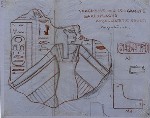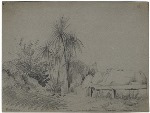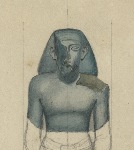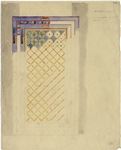Joseph Bonomi (1796-1878)
Drawings and watercolours in the Archive of the Griffith Institute
Joseph Bonomi was a British sculptor, draughtsman and illustrator, who travelled extensively in Egypt
between 1824 and 1844 during which time he amassed an impressive portfolio of drawings and watercolours
of Egypt's monuments, ancient and modern. During this period Bonomi worked alongside some of the best-known
scholars of the first half of the 19th century, these included Robert Hay, James Burton, Edward W. Lane,
Sir John Gardner Wilkinson, and Ippolito Rosellini. Bonomi was also a member of Richard Lepsius's expedition
to Egypt between 1842 and 1844.
Bonomi was involved in numerous projects in Britain which drew on his extensive knowledge of ancient Egyptian
monuments: he was commissioned by Robert Hay to make plaster casts of monuments in Egypt, the resulting casts were
then installed by Bonomi in the British Museum; he produced the drawings used for the engravings in Wilkinson's
Manners and Customs of the ancient Egyptians published in 1837; designed the Egyptian elements of John
Marshall's flax mill in Leeds (the Temple Mill), which Bonomi modelled after the Temple of Horus at Edfu; and
directed the design and construction of the Egyptian Court at the Crystal Palace in 1853. Bonomi was
appointed the first Curator of Sir John Soane's Museum, a position he held from 1861 until his death in 1878.
After Bonomi's death his papers were divided up between members of his family, the papers in the Griffith
Institute Archive were presented in 1997 by one of his descendants who lived locally to Oxford. The material
in the Archive consists of over 2000 sketches, watercolours, tracings, notes and prints. They date to
various periods of Bonomi's career and include Egyptian as well as Classical, 19th-century Egyptian and other
subjects (including Palestine). The Egyptian material contains general views of monuments, such as
Trajan's kiosk at Philae and the
temple-remains at Elephantine,
copies of various artefacts including
a fragment of the sarcophagus of King Ay,
and
objects in the John Lee collection at Hartwell House, and
Egyptian influenced designs.
Since 2017 the collection is being catalogued and presented online in the Institute's
online catalogue with volunteer assistance, including BA students in Art History (placement programme).
[Original post 14 May 1997. Last updated 26 February 2021]







!['Ancient tombs', Aswan, Bonomi MSS. 6.7 [upper] Bonomi MSS. 6.7 [upper]](http://www.griffith.ox.ac.uk/gri/gif-files/Bonomi_06_7_uppers.jpg)
![Egyptian design with lilies, Bonomi MSS. 3.50 [recto] Bonomi MSS. 3.50](http://www.griffith.ox.ac.uk/gri/gif-files/Bonomi_03_50_rectos.jpg) Joseph Bonomi material in other collections
Bonomi correspondence and
material, held at Cambridge University Library, Department of Manuscripts and University Archives.
Correspondence,
Joseph Bonomi to Samuel Sharpe, sent between 1857 and 1878, held at the British Museum, Archive of the Department of Ancient Egypt and Sudan.
Portrait of Joseph Bonomi the Younger, painted by Matilda Sharpe, National Portrait Gallery.
Joseph Bonomi material in other collections
Bonomi correspondence and
material, held at Cambridge University Library, Department of Manuscripts and University Archives.
Correspondence,
Joseph Bonomi to Samuel Sharpe, sent between 1857 and 1878, held at the British Museum, Archive of the Department of Ancient Egypt and Sudan.
Portrait of Joseph Bonomi the Younger, painted by Matilda Sharpe, National Portrait Gallery.


